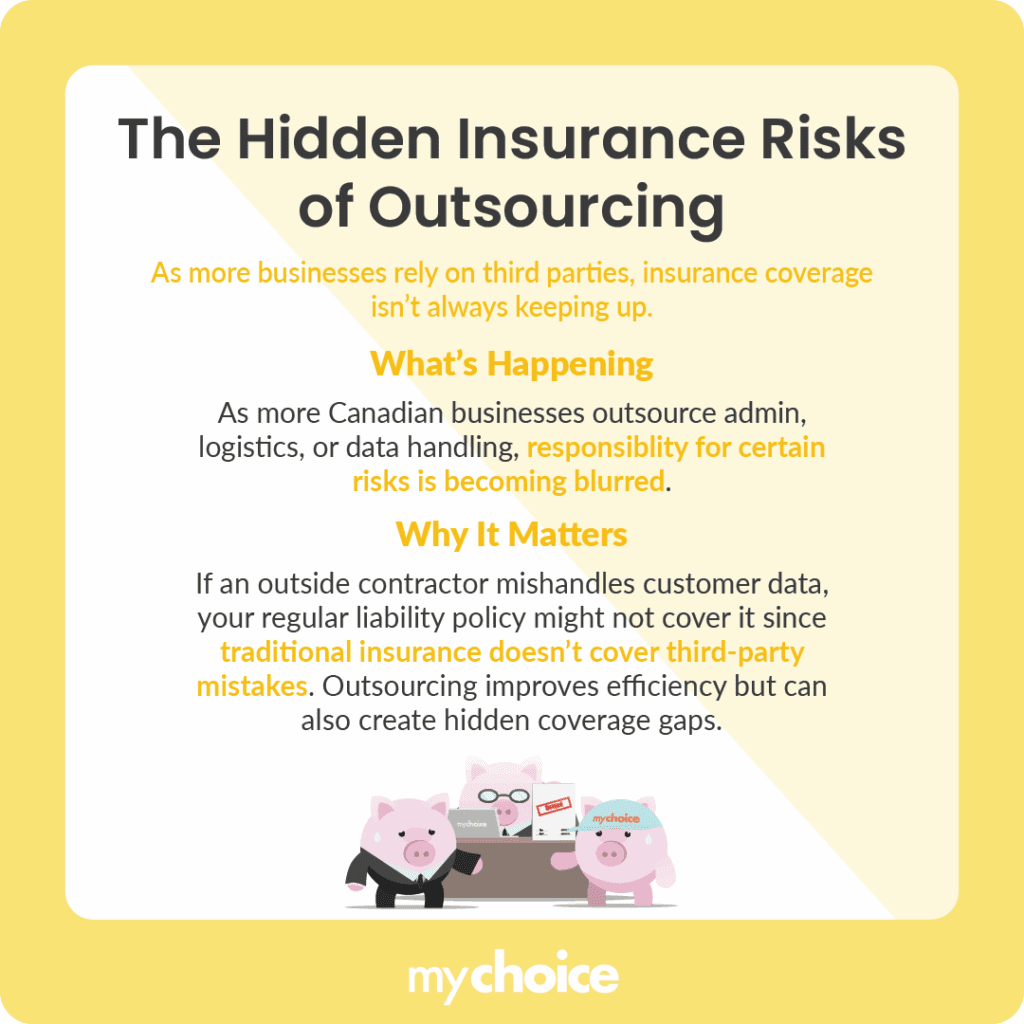With businesses in Canada increasingly relying on outsourced service providers, insurance gaps can quietly creep in. Let’s walk through what to watch out for, why outsourcing raises unique risks, and how to get properly covered.
Why Outsourcing Has Become a Hidden Insurance Challenge
As Canadian businesses shift more non-core tasks like administration and logistics to external providers, the question of who bears the risk becomes fuzzier. Traditional business insurance policies were built around direct employees and known operations. When you introduce third parties, the risk landscape changes in ways that your insurer may not have anticipated.
For example, if you contract a third party to handle customer data and they suffer a breach, your standard liability policy might not clearly cover that scenario. Outsourcing opens doors to new business efficiencies, but also to insurance gaps that many Canadian businesses overlook.

The 5 Most Common Insurance Gaps in Outsourced Work
| Gap | What Happens | Real-world Example | How to Close It |
|---|---|---|---|
| Unverified Contractor Liability Coverage | You hire a contractor assuming they carry professional/general liability insurance, but they don’t, or their coverage is very limited. | A contractor does installation work, causes damage, and your business gets sued, but the contractor carries insufficient insurance. | Require proof of insurance that names your business as additional insured. |
| No Coverage for Subcontractors | The contractor you hire uses subcontractors, but the insurance only covers the primary contractor, not the subs. | Your vendor hires a subcontractor to do finishing work; that sub causes a defect, but only the primary vendor’s limited insurance applies. | Have all your contracts require all subs to carry insurance, or state that the main contractor’s insurance specifically covers subcontractors. |
| Professional Errors Without Indemnity | Outsourced work involving professional services lacks Errors & Omissions (E&O) or professional liability cover. | A designer hired overseas produces faulty specs; you suffer a loss, but the designer’s standard general liability doesn’t cover design errors or professional negligence. | Ask for professional liability / E&O insurance from those doing professional/technical work; make you’re named in it if needed. |
| Data Breach from Outsourced Service Providers | A third-party vendor suffers a data breach, and your business is exposed for regulatory penalties, client claims or remediation costs, yet the vendor’s insurance may not cover it or you may not be included. | You outsource customer support to a call centre abroad; their system is hacked, and you face notices and possible regulatory fines under Canadian privacy laws. | Confirm the vendor has cyber liability/data breach insurance; contractually require coverage for related losses and ensure your policy considers outsourced providers. |
| Misclassification of Workers | If a regulatory body later deems your contractors should have been employees, your business can face liabilities for employment, benefit and workers’ compensation gaps. | You engage a long term contractor who is later deemed an employee; you were relying on them being independent and didn’t carry employee liability cover. | Check classification rules provincially to treat long-term independent contractors correctly. |
Why Traditional Business Insurance May Not Be Enough
Many standard commercial general liability (CGL) policies assume you’re covering your direct employees, your listed operations and your in-house premises. This means that they may exclude liability tied to subcontractors, independent contractors, outsourced operations, cross-border exposures, or specific professional errors.
Note as well that your policy might only apply if you have control over the work environment, which you often don’t with fully outsourced work. In sum? Just because you’re insured doesn’t always mean all the risk from outsourced work is automatically covered.
How to Insure Outsourced and Contracted Work Properly
Ensuring outsourced and contracted work is properly managed involves knowing what to ask for and building risk management into every outsourcing relationship. Here’s how you can close those gaps and keep coverage airtight:
- Check vendor’s insurance: Ask for certificates of insurance and verify policy limits and expiration dates.
- Adapt your policy: Talk with your insurer about extending your policy to cover outsourced work.
- Clarify worker classification: Worker classification rules vary by province. Make sure independent contractors are truly independent to avoid coverage and legal issues.
- Consider cyber and professional liability cover: If you outsource digital, creative, or advisory work, these policies are essential to protect against costly mistakes or cyber risks like data incidents.
Key Advice from MyChoice
- Make sure your insurer knows about all outsourced work you do. Some policies require you to disclose vendor arrangements so the underwriter can assess the risk.
- Review your insurance and contracts regularly to keep everything aligned with your current operations.
- Treat third parties as part of your operational ecosystem. Understand how and where they handle your data, who their subcontractors are, and what jurisdictions apply to their work.








